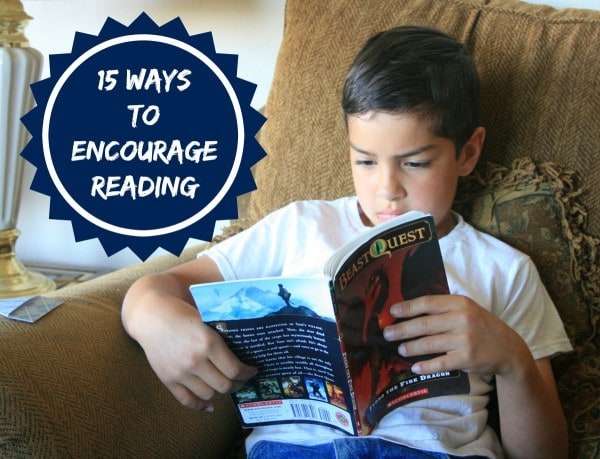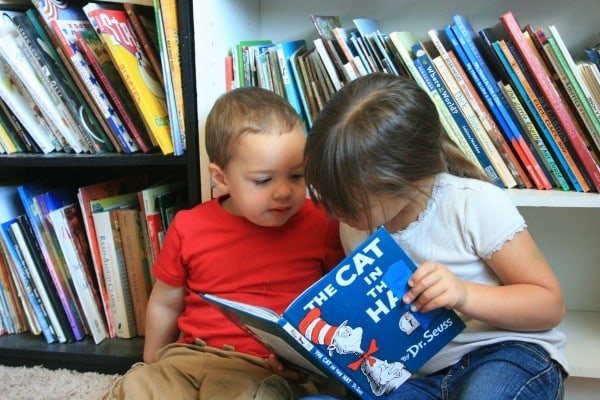Reading is truly one of the best things in the world! But how do you convince a child who would rather muck out a chicken coop or eat a bowl of brussels sprouts that reading really is fun?
Reading is one of the true pleasures of life. In our age of mass culture, when so much that we encounter is abridged, adapted, adulterated, shredded, and boiled down, it is mind-easing and mind-inspiring to sit down privately with a congenial book. (Thomas S. Monson, Hallmarks of a Happy Home)
Here’s a list of 15 ways to encourage reading, tried and true in my own family with my own kids.
1. Look for books your kids might like to read. Use their interests and hobbies as starting points. My son, Ira, really loves knights and castles and dragons but he wasn’t wanting to read for pleasure. It was much more fun to play with his toys. I searched for a few books about knights and dragons and started reading them with him. Now he can be seen with a book close by. He is always telling us what is happening in the book and what he thinks will happen next. I love it!
2. Building on the previous suggestion, pay attention to what fascinates your children, even if they only look at the pictures. Do they get excited when they see hot air balloons or motorcycles or roses? Find easy reader books about those topics to read to them and with them. They’ll come to realize that reading is a fun way of gathering information.
3. Think outside the box. Maybe books are too intimidating because there are so many pages and words. Try comic books or magazines instead. When my brother was about 8 years old he did not want to read at all, let alone read books. My parents asked him what he would like to read and he said comic books. My dad took him to the store and helped him pick out comic books and, sure enough, it got him started on his love of reading.
4. Utilize the library! I have fond memories of my mom taking us all to the library during the summer when we lived in Miami, FL. In the children’s section were places to read built into the wall. I loved grabbing a pile of books and climbing up into one of those small spaces and just reading. We have the wonderful pleasure of having a bookmobile come to our house every other Monday. Everyone else in the valley comes to check out books and movies, the kids play with each other, while the adults talk. Most libraries have activities, summer reading programs, and story times to get kids involved in reading. Ask a librarian to suggest books and magazines your children might enjoy.
5. Encourage older children to read to their younger brothers and sisters. Encourage younger siblings to read to their older brothers and sisters (and make sure those older ones know to be enthusiastic and a cheering squad to bolster confidence in beginning readers).
6. Set an example by reading books on your own in front of your children. Talk to them about what you are reading.
7. Read aloud to your children, especially to a child who is discouraged by his or her own poor reading skills. We enjoy family read-alouds, reading books the whole family from tots to teens enjoy. Stopping at a particularly exciting part can get reluctant readers to pick up the book on their own to see what happens next.
8. Play games that are reading-related. Apples to Apples Junior is a favorite around here as is Scrabble
.
9. Give books and magazines as gifts. Personally, I LOVE the smell of a new book. I flip the pages breathing it in. But I also love the feel and look of old books, spines weathered with time, pages worn and edges brown. I keep a collection of hardcover copies of my favorite children’s book, Just David, to give away.
10. Create a special spot for children to keep their own books.
11. With the help of your child make book labels with their name on them to put inside their very own copies of books. Alternatively, here’s a nice round-up of free printable bookplates to choose from.
12. Reading doesn’t have to be serious all the time. Check out riddle or joke books from the library and spend time in the evening passing the book around for everyone to reads jokes aloud to each other.
13. Use reading charts to keep track of progress and, yes, even offer little incentives for time spent reading.
14. Build upon your child’s positive reading experiences. For example, visit a farm after reading about animals or tractors or if your child enjoyed a book about dinosaurs, follow up with a visit to a natural history museum.
15. Find a penpal, a grandparent, or favorite aunt, uncle or cousin your child can write letters to. They will look forward to receiving and reading the letters they get back in the mail.
What are other ways to encourage reading that you have tried?


My 13 year old son has always struggled with reading. His sister was reading the “39 Clues” series and loved them. She got him interested in them by reading the first book to him. The best way we found to interest him was getting the book on CD from the library. He got through 3 of the different series of “39 Clues” (21 books total) in about 5 months. That was HUGE for him. The only catch is he needs to have the book in hand and read along with the CD :). Some of his younger brothers would listen along with him as well.
AuntSue
My last child was a reluctant reader. His sister gave him the first Harry Potter for Christmas. But he never opened it. As an addicted reader, I picked it up and realize it would be a great read aloud. So I started reading to him, and soon he wanted to take turns. Soon he became excited about the book and read it on his own. The first book took three weeks. The second, two weeks. The third a four day weekend. When he caught up with the author, he was reading at grade level in fifth grade.
One help was that the hard bound books we checked out of the library had fairly large type and lots of white space between the lines and around the page. Many children find it hard to read small type squished on the page.
Thanks for the ideas.
I remember an NPR episode where they interviewed this lady that had taught kindergarten for 50 years in Georgia. She recounted how out of those 50 years there was never a student from her class that finished the first grade that did not know how to read. She read Moby Dick with the students every year. Some did not know how to read and some were “readers”. She had note books with the main text above and a few of the easier and sight words below listed out that the “newbies” got to read. The new readers got so interested in the story that they learned the other words.
Moby Dick , every year for 50 years and all became readers!!!
Our house rule is that you .must read the book before you can see the movie- Harry Potter, The Hobbit, etc. My nephew had great success with an ereader because he could enlarge the font and because the slim profile with one page visible at a time was much less intimidating than a thick volume. I think that seeing my husband and I with our faces stuck in books all the time is also a factor in my kids reading success.
I love how gentle and encouraging these ideas are, with an emphasis on sharing a loved experience rather than nagging or duty. That always seems like the best way to help kids do anything, really, and it’s something I need to work on doing more consistently! Thanks for the great ideas.
Read a book about food and then eat that food. For example, Cloudy with a Chance of Meatballs is just begging to be read with a spaghetti dinner. If You Give a Mouse a Cookie series are all perfect for accompanying treats.
We have a special needs son (now grown), that hated reading as a child. His dad cut out words and glued them to the floor of the tree house, climbed up there with him, and made a game out of recognizing words as pictures of the word. Example C-A-T was a picture of the word cat. He still does not have a love for reading, but at least, now, he can read.